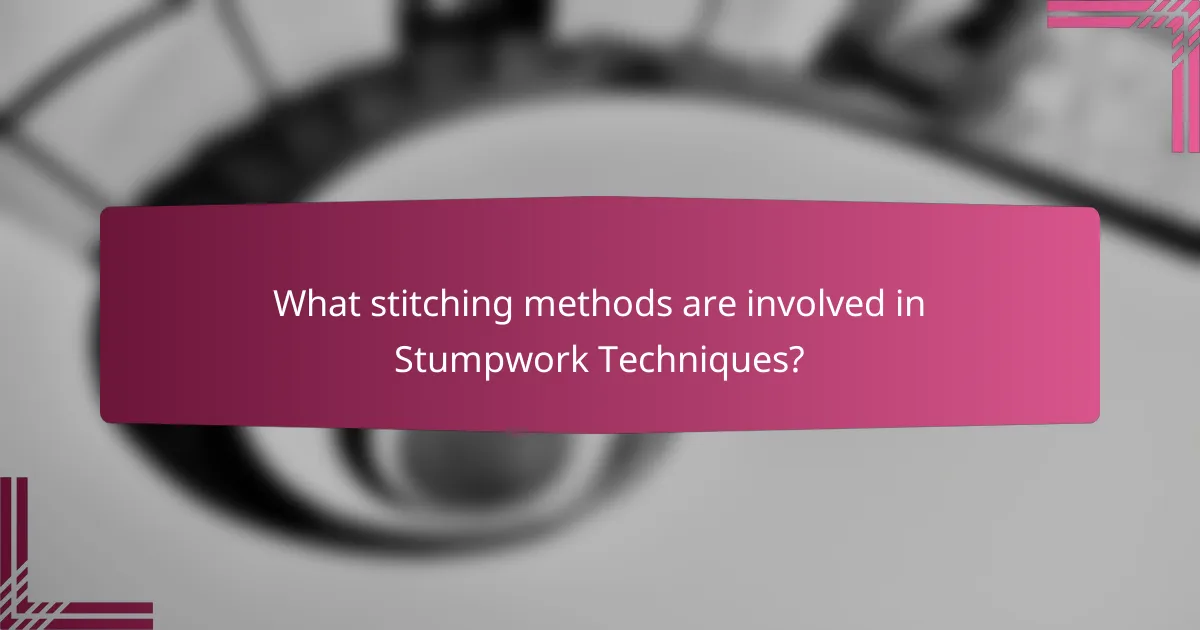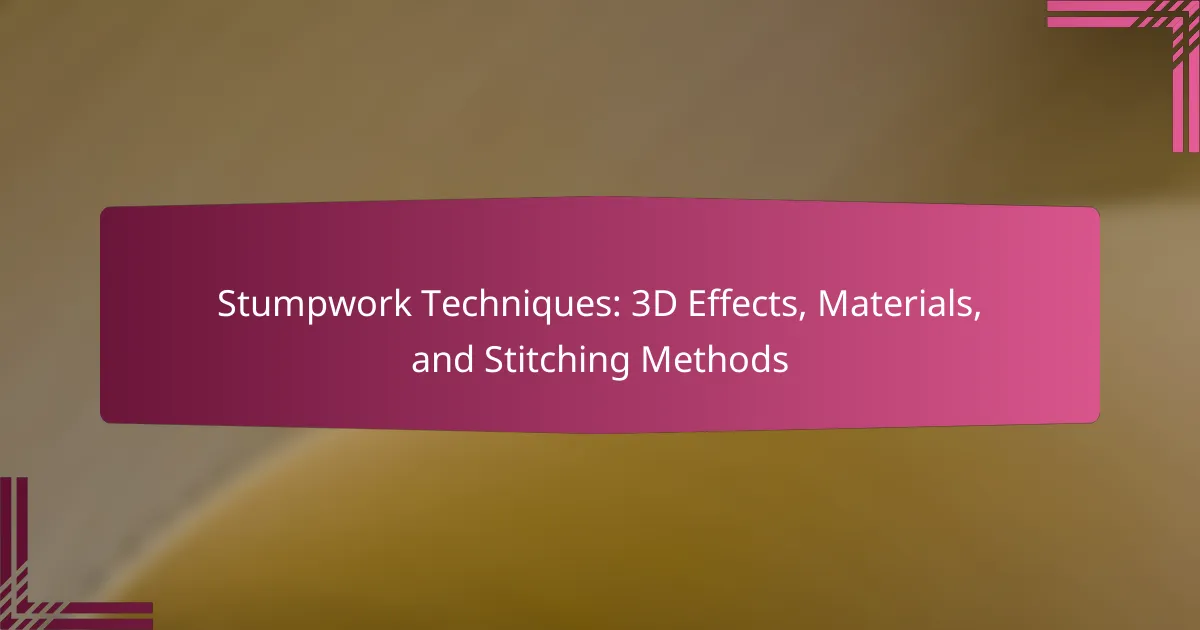
What are Stumpwork Techniques?
Stumpwork techniques are a form of embroidery that creates three-dimensional effects. This method involves raising certain elements of the design off the fabric surface. Stumpwork typically uses a variety of stitches and materials, such as wire, to achieve its unique textures. The technique dates back to the 17th century, primarily in England. Historically, stumpwork was used to embellish household items and personal accessories. It often features motifs like flowers, animals, and figures. Artisans employ a range of stitching methods, including satin stitch and couching, to create depth. The intricate nature of stumpwork makes it a specialized craft within the embroidery community.
How did Stumpwork Techniques originate?
Stumpwork techniques originated in the 17th century during the English embroidery movement. This form of embroidery developed as a method to create three-dimensional effects on fabric. Artisans utilized raised stitches and padding to achieve depth and texture. The techniques were often used to embellish household items and clothing. Stumpwork became popular due to its intricate designs and the use of colorful threads. Historical examples can be found in various textiles from this period, showcasing floral and animal motifs. The practice reflects the artistic trends and craftsmanship of the time.
What historical contexts influenced the development of Stumpwork?
Stumpwork developed during the late 16th to early 17th centuries in England. This period saw a rise in the popularity of embroidery as a decorative art. The influence of the Elizabethan era’s interest in intricate crafts played a significant role. Additionally, the availability of new materials from trade, such as silk and metallic threads, enhanced the techniques used. The cultural exchange with Europe introduced new styles and motifs, further shaping Stumpwork. This art form was also linked to the domestic sphere, reflecting the status and skills of women in society. The combination of these factors created a fertile ground for the evolution of Stumpwork techniques.
Who were the key figures in the evolution of Stumpwork Techniques?
Key figures in the evolution of Stumpwork techniques include Mary Thomas and the Royal School of Needlework. Mary Thomas published influential books in the early 20th century, showcasing various techniques. The Royal School of Needlework, established in 1872, has played a significant role in preserving and teaching these techniques. Additionally, contemporary artists like Rachael Wright have contributed to the modern interpretation of Stumpwork. Their works often blend traditional methods with innovative designs, ensuring the technique’s relevance today.
What are the core principles of Stumpwork Techniques?
The core principles of Stumpwork techniques involve creating three-dimensional embroidery. This technique utilizes raised stitches to form sculptural elements. It often incorporates wire and padding to achieve depth. Stumpwork emphasizes the use of various stitches for texture. Common stitches include satin stitch, couching, and French knots. The design often features motifs from nature, such as flowers and insects. Historical examples date back to the 17th century, showcasing intricate craftsmanship. These principles guide the creation of visually striking and tactile embroidery pieces.
How do Stumpwork Techniques differ from traditional embroidery?
Stumpwork techniques differ from traditional embroidery by incorporating three-dimensional elements. Traditional embroidery typically involves flat stitching on fabric surfaces. In contrast, stumpwork elevates designs by creating raised motifs using padding and wire frames. This technique allows for intricate textures and shapes, enhancing visual depth. Stumpwork often utilizes a variety of materials, such as beads and sequins, to further embellish the designs. Additionally, stumpwork stitches are often more varied and complex than those used in traditional embroidery. The historical context of stumpwork dates back to the 17th century, showcasing its unique artistic evolution compared to conventional embroidery practices.
What are the essential elements that define Stumpwork Techniques?
Stumpwork techniques are defined by their three-dimensional effects, unique materials, and specific stitching methods. The three-dimensional effects create raised designs that stand out from the fabric. Common materials used include embroidery threads, felt, and wire, which contribute to the structure. Specific stitching methods such as couching, satin stitch, and French knots are integral to the technique. Historically, stumpwork originated in the 17th century, showcasing intricate designs in embroidery. This combination of elements allows for creativity and depth in textile art.

What materials are used in Stumpwork Techniques?
Stumpwork techniques utilize various materials for effective execution. Commonly used materials include fabric, thread, and embroidery floss. Cotton and silk fabrics are often preferred for their texture and durability. Specialty threads, such as metallic or variegated options, add visual interest. Additionally, padding materials like felt or batting create the desired 3D effect. Beads and sequins may also be incorporated for embellishment. The combination of these materials enhances the overall design and depth of stumpwork projects.
What types of fabrics are suitable for Stumpwork?
Suitable fabrics for Stumpwork include cotton, linen, and silk. Cotton is commonly used due to its durability and ease of handling. Linen offers a slightly textured surface, providing good support for raised stitches. Silk is often chosen for its luxurious appearance and sheen, enhancing the visual impact of the embroidery. These fabrics are ideal as they can hold the structure needed for 3D effects in Stumpwork.
How do different fabrics impact the final appearance of Stumpwork?
Different fabrics significantly impact the final appearance of Stumpwork. Fabrics like linen provide a textured surface, enhancing the dimensionality of the embroidery. Cotton offers a smoother finish, which can result in more defined stitches. Silk adds a sheen, creating a luxurious look that highlights intricate details. Velvet, with its rich texture, can produce a soft, plush appearance. Each fabric’s weight and drape affect how the stitches lay, influencing the overall depth and structure of the design. Additionally, the fabric’s color can alter the visual impact, as brighter fabrics may make colors pop while darker ones can create a more subdued effect.
What are the best practices for selecting fabrics for Stumpwork?
Select fabrics with a firm weave for Stumpwork. A firm weave provides necessary support for raised embroidery techniques. Cotton and linen are preferred due to their durability and ability to hold stitches well. Choose fabrics in light colors to enhance visibility of stitches. Light colors also help showcase the texture of the work. Avoid stretchy or slippery fabrics as they complicate the stitching process. Pre-wash fabrics to eliminate shrinkage and ensure stability during stitching. Test fabric samples with your chosen threads to confirm compatibility.
What threads and embellishments are commonly used in Stumpwork?
Common threads used in Stumpwork include cotton embroidery floss, silk threads, and metallic threads. Cotton embroidery floss provides a versatile option for various stitches. Silk threads add a luxurious sheen and smooth texture. Metallic threads contribute sparkle and dimension to the work.
Embellishments often include beads, sequins, and wire. Beads can enhance the visual appeal with color and texture. Sequins add reflective qualities, creating eye-catching highlights. Wire is frequently used to create three-dimensional effects and structure in the designs.
These materials are integral to achieving the distinctive raised and textured effects characteristic of Stumpwork. Their use has been documented in historical embroidery practices, showcasing their importance in this craft.
How do various threads contribute to the 3D effects in Stumpwork?
Various threads contribute to the 3D effects in Stumpwork by providing different textures and depths. Thicker threads create raised areas, adding dimension. Varied colors enhance visual interest and realism. Specialty threads, like metallic or variegated types, introduce unique light reflections. The choice of thread also influences the overall drape and structure of the piece. Techniques such as padding with thread layers amplify the three-dimensionality. Additionally, the interplay of thread types can simulate natural elements like foliage or animal fur. This combination of attributes results in a rich, tactile experience in Stumpwork designs.
What embellishments enhance the visual appeal of Stumpwork projects?
Embellishments that enhance the visual appeal of Stumpwork projects include beads, sequins, and fabric paints. Beads add texture and sparkle, creating an eye-catching effect. Sequins offer a reflective quality, enhancing light play on the piece. Fabric paints can be used to add depth and color variations. These embellishments are often used strategically to highlight specific areas. Historical references show that such embellishments have been used in Stumpwork since the 17th century. Their application contributes to the overall richness and dimensionality of the artwork.

What stitching methods are involved in Stumpwork Techniques?
Stumpwork techniques involve several stitching methods. Key methods include satin stitch, split stitch, and backstitch. Satin stitch creates smooth, filled areas. Split stitch provides a textured outline and can be used for detailing. Backstitch is often employed for outlining shapes. Other methods include French knots for adding dimension and surface embellishment. Each method contributes to the three-dimensional effects characteristic of stumpwork. These techniques enhance the visual appeal and tactile quality of the embroidery.
What are the primary stitching techniques used in Stumpwork?
The primary stitching techniques used in Stumpwork include satin stitch, chain stitch, and couching. Satin stitch creates smooth, flat areas of color. Chain stitch forms a series of connected loops, adding texture. Couching involves laying down a thread and stitching over it to secure it, providing dimension. These techniques are essential for achieving the characteristic 3D effects in Stumpwork. Each technique contributes to the overall aesthetic and intricacy of the embroidery.
How do different stitching methods create depth and dimension in Stumpwork?
Different stitching methods create depth and dimension in Stumpwork through varied techniques that manipulate fabric and thread. Techniques such as padding, layering, and using different stitch types contribute to a three-dimensional effect. Padding involves adding layers of fabric or thread beneath stitches, elevating the design. Layering stitches in different directions enhances texture and visual interest. Techniques like the French knot or satin stitch create raised areas, adding dimensionality. Additionally, varying thread thickness can influence the perception of depth. These methods collectively create intricate and lifelike representations in Stumpwork embroidery.
What are the step-by-step processes for executing these stitching techniques?
To execute stumpwork stitching techniques, follow these steps: First, gather necessary materials such as fabric, embroidery thread, needles, and scissors. Next, transfer your design onto the fabric using a fabric pen or chalk. Then, select appropriate stitches for the design, such as satin stitch or buttonhole stitch. After that, start stitching the outline of your design, securing the fabric tightly in an embroidery hoop. Once the outline is complete, fill in the design with chosen stitches to create texture and depth. Next, add 3D elements by using padding or wire to elevate certain areas. Finally, finish the piece by trimming excess fabric and securing any loose threads. These steps ensure a structured approach to executing stumpwork techniques effectively.
How can beginners learn Stumpwork Techniques effectively?
Beginners can learn Stumpwork techniques effectively by starting with comprehensive resources. Online tutorials and video demonstrations provide visual guidance. Beginner-friendly patterns simplify the learning process. Practicing basic stitches builds foundational skills. Joining embroidery groups offers community support and feedback. Workshops and classes provide hands-on experience. Using quality materials enhances the learning experience. Regular practice solidifies techniques and boosts confidence.
What resources are available for mastering Stumpwork Techniques?
Books on stumpwork techniques include “Stumpwork Embroidery” by Jane Nicholas. Online courses are available on platforms like Craftsy and Skillshare. Video tutorials can be found on YouTube, featuring experienced stitchers. Additionally, forums and community groups on Facebook and Reddit offer support and advice. Local craft stores may host workshops and classes. These resources provide comprehensive guidance for mastering stumpwork techniques.
What common mistakes should beginners avoid when practicing Stumpwork?
Beginners should avoid several common mistakes when practicing Stumpwork. One mistake is not using the right materials. Using inappropriate fabric can lead to poor results. Another mistake is neglecting to plan the design. A clear design helps in achieving desired 3D effects. Additionally, beginners often underestimate the importance of tension. Maintaining consistent tension is crucial for even stitching.
Failing to secure stitches properly is another common error. Loose stitches can cause the work to unravel. Beginners may also rush the process. Taking time to refine techniques leads to better outcomes. Lastly, not practicing basic stitches can hinder skill development. Mastering foundational stitches is essential for successful Stumpwork.
What are the best practices for creating stunning Stumpwork projects?
To create stunning Stumpwork projects, start with a clear design plan. This involves sketching your ideas and selecting a color palette. Use high-quality materials like cotton or silk threads and fine fabrics. Incorporate various stitches to add texture and dimension. Techniques such as padding and layering enhance the 3D effect. Ensure proper tension in your stitching for a polished look. Regularly step back to evaluate your work and make adjustments as needed. Lastly, finishing techniques like framing or mounting can elevate the overall presentation of your project.
Stumpwork techniques are a specialized form of embroidery that creates three-dimensional effects through raised elements on fabric. Originating in 17th century England, this craft utilizes various stitches, materials, and embellishments to produce intricate designs featuring motifs such as flowers and animals. The article covers the historical context, core principles, essential materials, stitching methods, and best practices for creating stunning stumpwork projects, providing a comprehensive overview for both beginners and experienced artisans.
